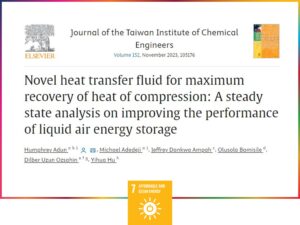
A collaborative study involving a researcher Özşahin from Operational Research Center in Healthcare, Near East University introduces a approach to energy storage through Liquid Air Energy Storage (LAES) technology. Addressing the challenge of managing the variability of renewable energy sources, the study focuses on enhancing LAES performance by optimizing heat transfer fluids.
During the charging stage of LAES, heat generated from compressing ambient air is stored in a heat storage tank for later power recovery. However, LAES systems face issues with low round-trip efficiency. To overcome this, researchers have explored various system configurations and materials, including multigeneration systems and packed beds, as well as incorporating fluids for cold storage.
In this study, a novel nanofluid analysis is conducted to enhance heat recovery during the charging process of ambient air. The analysis investigates the impact of hybridization and volume fraction of carbon nanotubes, comparing them with other oils such as Therminol-VP1, Therminol-66, and Dowtherm Q.
Results indicate that nanofluid@0.005 requires a storage tank volume of 3331 m3, resulting in the lowest investment cost of $2.318 million for the high-temperature storage tank. Furthermore, the levelized cost of storage for LAES systems utilizing different fluids is calculated, with nanofluid@0.005 demonstrating the most cost-effective solution at $208.4/MWh.
Overall, this study marks a significant advancement in LAES technology by introducing nanofluids as a viable option for improving heat recovery and overall system efficiency. The findings pave the way for future research and implementation of innovative solutions in energy storage, contributing to the sustainable management of renewable energy resources.
More Information:
https://www.sciencedirect.com/science/article/pii/S1876107023005059